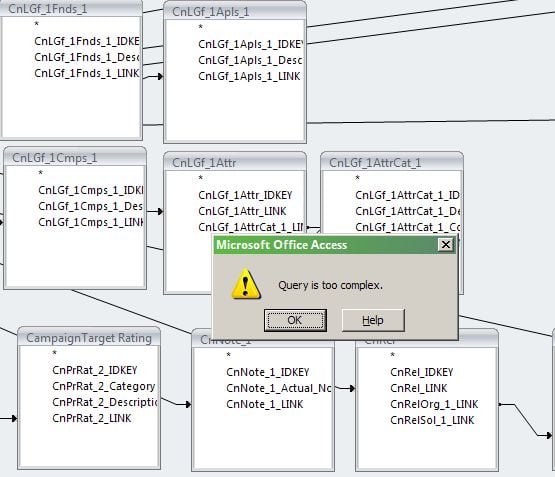Which version of Excel for Exporting?
In a previous workplace, a co-worker was sometimes very particular about which version I selected and I never understood why. I don't know what the significant differences are, and I usually just choose the latest version. If there are tangible reasons for using other versions, I would be interested in learning them.
Comments
-
I always use Excel 2007 (XLSX). Everyone here has Office 2010 or newer so it would seem like a missed opportunity not to take advantage of the extra functionality. Plus, less computer literate users may not fully understand the implications of the "loss of fidelity" warning when saving as an older format and I wouldn't want anyone to lose aspects of their work because I picked a format that didn't support the colour scheme they decided to use, for example.
Anecdotally, I find the file size is generally smaller with XLSX than with XLS but I suppose that could depend on the contents of the file.3 -
My default format is to export as a csv file - this allows me to control the formatting after I open. I find that if I choose any of the available choices for Excel files - then any of the numberical fields come out as labels instead of numbers. Starting with a csv eliminates the need to reformat columns.4
-
Alan French:
I always use Excel 2007 (XLSX). Everyone here has Office 2010 or newer so it would seem like a missed opportunity not to take advantage of the extra functionality. Plus, less computer literate users may not fully understand the implications of the "loss of fidelity" warning when saving as an older format and I wouldn't want anyone to lose aspects of their work because I picked a format that didn't support the colour scheme they decided to use, for example.
Anecdotally, I find the file size is generally smaller with XLSX than with XLS but I suppose that could depend on the contents of the file.These are the reasons I usually go with the latest version, as well. Curiously, the format about which my former co-worker was so particular was Excel version 8.0 (extended), if I remember correctly, which I don't see available anymore. Seemed like a very particular sort of request, especially for such an old format.
0 -
Candace Chesler:
My default format is to export as a csv file - this allows me to control the formatting after I open. I find that if I choose any of the available choices for Excel files - then any of the numberical fields come out as labels instead of numbers. Starting with a csv eliminates the need to reformat columns.
Nice trick! Is this why my leading zeroes get dropped sometimes?0 -
Daniel Noga:
Alan French:
I always use Excel 2007 (XLSX). Everyone here has Office 2010 or newer so it would seem like a missed opportunity not to take advantage of the extra functionality. Plus, less computer literate users may not fully understand the implications of the "loss of fidelity" warning when saving as an older format and I wouldn't want anyone to lose aspects of their work because I picked a format that didn't support the colour scheme they decided to use, for example.
Anecdotally, I find the file size is generally smaller with XLSX than with XLS but I suppose that could depend on the contents of the file.These are the reasons I usually go with the latest version, as well. Curiously, the format about which my former co-worker was so particular was Excel version 8.0 (extended), if I remember correctly, which I don't see available anymore. Seemed like a very particular sort of request, especially for such an old format.If you export a canned Raisers Edge report, Excel 8.0 extended is one of the options. If you use the Extended format, it gives you additional options regarding the format, which helps to line it up better when you export.
2 -
I vote .cvs comma delimited - other formats have hidden characters that pop up at the most inconvenient times!
2 -
I export it as 2007 or csv then save it as the version my organization uses (2013) after I open it.1
-
Whatever the latest available version of Excel is available for the Export (currently 2007). I've never had a problem with ANY of the Excel formats when doing an Export. Exporting from a previewed Report is a different matter altogether and can be very hit & miss.1
-
Another vote for CSV here. I like to keep the export simple and then save into an appropriate file format after the fact.3
-
Daniel Noga:
Alan French:
I always use Excel 2007 (XLSX). Everyone here has Office 2010 or newer so it would seem like a missed opportunity not to take advantage of the extra functionality. Plus, less computer literate users may not fully understand the implications of the "loss of fidelity" warning when saving as an older format and I wouldn't want anyone to lose aspects of their work because I picked a format that didn't support the colour scheme they decided to use, for example.
Anecdotally, I find the file size is generally smaller with XLSX than with XLS but I suppose that could depend on the contents of the file.These are the reasons I usually go with the latest version, as well. Curiously, the format about which my former co-worker was so particular was Excel version 8.0 (extended), if I remember correctly, which I don't see available anymore. Seemed like a very particular sort of request, especially for such an old format.I default to Excel 97-2000 (extended) because exporting to 2007 (at least when we first started using it) would export dollar amounts as standard numbers. A lot of our development officers will run their own exports and it's easier for them to not have to reformat, but just start looking.
0 -
I use character separated text, because then I don't have issues with commas in addresses and salutations, and with numbers coming out with the apostrophe in front and getting treated like text, and all of the other screwiness involved in exporting directly to Excel. Excel is usually pretty good at figuring out formats as it imports.
0 -
I almost never send things out as csv, but that might help with the "looks like a number - treat as number?" issues I have. Sorting zips and zips-plus-4 together is always a nightmare. I'll have to find the free time to export the same list in several versions/formats and then try to do typical things with each. Thanks for hte suggestion!0
-
I think the various cases made for .csv win out, especially since one can always convert the .csv to another format if needed. The advantages of bypassing formatting issues are compelling and, to my mind, come before other considerations that seem a bit more aesthetic/based on personal preference. This is especially the case since it's possible to overlook those formatting issues and send out a faulty report if they aren't caught.
0
Categories
- All Categories
- Shannon parent
- shannon 2
- shannon 1
- 21 Advocacy DC Users Group
- 14 BBCRM PAG Discussions
- 89 High Education Program Advisory Group (HE PAG)
- 28 Luminate CRM DC Users Group
- 8 DC Luminate CRM Users Group
- Luminate PAG
- 5.9K Blackbaud Altru®
- 58 Blackbaud Award Management™ and Blackbaud Stewardship Management™
- 409 bbcon®
- 2.1K Blackbaud CRM™ and Blackbaud Internet Solutions™
- donorCentrics®
- 1.1K Blackbaud eTapestry®
- 2.8K Blackbaud Financial Edge NXT®
- 1.1K Blackbaud Grantmaking™
- 527 Education Management Solutions for Higher Education
- 1 JustGiving® from Blackbaud®
- 4.6K Education Management Solutions for K-12 Schools
- Blackbaud Luminate Online & Blackbaud TeamRaiser
- 16.4K Blackbaud Raiser's Edge NXT®
- 4.1K SKY Developer
- 547 ResearchPoint™
- 151 Blackbaud Tuition Management™
- 1 YourCause® from Blackbaud®
- 61 everydayhero
- 3 Campaign Ideas
- 58 General Discussion
- 115 Blackbaud ID
- 87 K-12 Blackbaud ID
- 6 Admin Console
- 949 Organizational Best Practices
- 353 The Tap (Just for Fun)
- 235 Blackbaud Community Feedback Forum
- 55 Admissions Event Management EAP
- 18 MobilePay Terminal + BBID Canada EAP
- 36 EAP for New Email Campaigns Experience in Blackbaud Luminate Online®
- 109 EAP for 360 Student Profile in Blackbaud Student Information System
- 41 EAP for Assessment Builder in Blackbaud Learning Management System™
- 9 Technical Preview for SKY API for Blackbaud CRM™ and Blackbaud Altru®
- 55 Community Advisory Group
- 46 Blackbaud Community Ideas
- 26 Blackbaud Community Challenges
- 7 Security Testing Forum
- 1.1K ARCHIVED FORUMS | Inactive and/or Completed EAPs
- 3 Blackbaud Staff Discussions
- 7.7K ARCHIVED FORUM CATEGORY [ID 304]
- 1 Blackbaud Partners Discussions
- 1 Blackbaud Giving Search™
- 35 EAP Student Assignment Details and Assignment Center
- 39 EAP Core - Roles and Tasks
- 59 Blackbaud Community All-Stars Discussions
- 20 Blackbaud Raiser's Edge NXT® Online Giving EAP
- Diocesan Blackbaud Raiser’s Edge NXT® User’s Group
- 2 Blackbaud Consultant’s Community
- 43 End of Term Grade Entry EAP
- 92 EAP for Query in Blackbaud Raiser's Edge NXT®
- 38 Standard Reports for Blackbaud Raiser's Edge NXT® EAP
- 12 Payments Assistant for Blackbaud Financial Edge NXT® EAP
- 6 Ask an All Star (Austen Brown)
- 8 Ask an All-Star Alex Wong (Blackbaud Raiser's Edge NXT®)
- 1 Ask an All-Star Alex Wong (Blackbaud Financial Edge NXT®)
- 6 Ask an All-Star (Christine Robertson)
- 21 Ask an Expert (Anthony Gallo)
- Blackbaud Francophone Group
- 22 Ask an Expert (David Springer)
- 4 Raiser's Edge NXT PowerUp Challenge #1 (Query)
- 6 Ask an All-Star Sunshine Reinken Watson and Carlene Johnson
- 4 Raiser's Edge NXT PowerUp Challenge: Events
- 14 Ask an All-Star (Elizabeth Johnson)
- 7 Ask an Expert (Stephen Churchill)
- 2025 ARCHIVED FORUM POSTS
- 322 ARCHIVED | Financial Edge® Tips and Tricks
- 164 ARCHIVED | Raiser's Edge® Blog
- 300 ARCHIVED | Raiser's Edge® Blog
- 441 ARCHIVED | Blackbaud Altru® Tips and Tricks
- 66 ARCHIVED | Blackbaud NetCommunity™ Blog
- 211 ARCHIVED | Blackbaud Target Analytics® Tips and Tricks
- 47 Blackbaud CRM Higher Ed Product Advisory Group (HE PAG)
- Luminate CRM DC Users Group
- 225 ARCHIVED | Blackbaud eTapestry® Tips and Tricks
- 1 Blackbaud eTapestry® Know How Blog
- 19 Blackbaud CRM Product Advisory Group (BBCRM PAG)
- 1 Blackbaud K-12 Education Solutions™ Blog
- 280 ARCHIVED | Mixed Community Announcements
- 3 ARCHIVED | Blackbaud Corporations™ & Blackbaud Foundations™ Hosting Status
- 1 npEngage
- 24 ARCHIVED | K-12 Announcements
- 15 ARCHIVED | FIMS Host*Net Hosting Status
- 23 ARCHIVED | Blackbaud Outcomes & Online Applications (IGAM) Hosting Status
- 22 ARCHIVED | Blackbaud DonorCentral Hosting Status
- 14 ARCHIVED | Blackbaud Grantmaking™ UK Hosting Status
- 117 ARCHIVED | Blackbaud CRM™ and Blackbaud Internet Solutions™ Announcements
- 50 Blackbaud NetCommunity™ Blog
- 169 ARCHIVED | Blackbaud Grantmaking™ Tips and Tricks
- Advocacy DC Users Group
- 718 Community News
- Blackbaud Altru® Hosting Status
- 104 ARCHIVED | Member Spotlight
- 145 ARCHIVED | Hosting Blog
- 149 JustGiving® from Blackbaud® Blog
- 97 ARCHIVED | bbcon® Blogs
- 19 ARCHIVED | Blackbaud Luminate CRM™ Announcements
- 161 Luminate Advocacy News
- 187 Organizational Best Practices Blog
- 67 everydayhero Blog
- 52 Blackbaud SKY® Reporting Announcements
- 17 ARCHIVED | Blackbaud SKY® Reporting for K-12 Announcements
- 3 Luminate Online Product Advisory Group (LO PAG)
- 81 ARCHIVED | JustGiving® from Blackbaud® Tips and Tricks
- 1 ARCHIVED | K-12 Conference Blog
- Blackbaud Church Management™ Announcements
- ARCHIVED | Blackbaud Award Management™ and Blackbaud Stewardship Management™ Announcements
- 1 Blackbaud Peer-to-Peer Fundraising™, Powered by JustGiving® Blogs
- 39 Tips, Tricks, and Timesavers!
- 56 Blackbaud Church Management™ Resources
- 154 Blackbaud Church Management™ Announcements
- 1 ARCHIVED | Blackbaud Church Management™ Tips and Tricks
- 11 ARCHIVED | Blackbaud Higher Education Solutions™ Announcements
- 7 ARCHIVED | Blackbaud Guided Fundraising™ Blog
- 2 Blackbaud Fundraiser Performance Management™ Blog
- 9 Foundations Events and Content
- 14 ARCHIVED | Blog Posts
- 2 ARCHIVED | Blackbaud FIMS™ Announcement and Tips
- 59 Blackbaud Partner Announcements
- 10 ARCHIVED | Blackbaud Impact Edge™ EAP Blogs
- 1 Community Help Blogs
- Diocesan Blackbaud Raiser’s Edge NXT® Users' Group
- Blackbaud Consultant’s Community
- Blackbaud Francophone Group
- 1 BLOG ARCHIVE CATEGORY
- Blackbaud Community™ Discussions
- 8.3K Blackbaud Luminate Online® & Blackbaud TeamRaiser® Discussions
- 5.7K Jobs Board
















